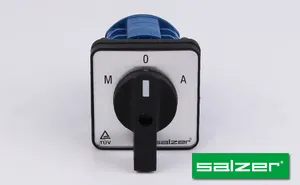Introduction to Manual Selector Switch
The manual selector switch is a critical component in various industrial and commercial applications, enabling users to control machinery and electrical circuits with precision. This versatile switch allows for the selection of multiple operating modes, enhancing operational flexibility and adaptability. Designed for ease of use and reliability, manual selector switches are indispensable in control panels, machinery, and various electronic devices.
Types of Manual Selector Switch
Manual selector switches come in various types, each catering to specific needs and functionalities. Understanding the differences will help you choose the most suitable option for your application:
- Rotary Selector Switch: A widely used type, operated by rotating the knob to select the required circuit position.
- Toggle Selector Switch: This switch utilizes a lever that you flip to change the operational mode, offering a tactile response.
- Pushbutton Selector Switch: Allows users to toggle between settings by pressing buttons, ideal for quick modifications in operation.
- Key-Operated Selector Switch: Provides additional security features by requiring a key to operate, suited for applications where limited access is necessary.
Function and Features of Manual Selector Switch
The manual selector switch boasts an array of functions and features that set it apart:
- Multi-Position Control: Enables users to toggle between multiple operational settings easily, facilitating versatile control functionalities.
- Durability: Built from high-quality materials, these switches withstand harsh industrial environments, ensuring longevity and reliability.
- Compact Design: The sleek design allows for easy integration into control panels without occupying excessive space.
- Visual Feedback: Many models come with illuminated indicators, providing visual confirmation of the selected position.
Applications of Manual Selector Switch
Manual selector switches find applications across various sectors, making them a critical component in numerous systems:
- Industrial Machinery: Utilized for machine operations, enabling users to shift between different machine modes with ease.
- Control Panels: Commonly installed in control panels to facilitate the management of multiple circuits and systems.
- Automotive Applications: Used in vehicles for selecting various operational modes, which enhances user experience.
- Home Appliances: Integrated into appliances for selection between different operational states, such as washing cycles or heating modes.




























































































































































![[dy]Excellent Materials <strong>Manual</strong> Rotary Changeover <strong>Switch</strong> Rotary Electric <strong>Selector</strong> <strong>Switch</strong>](http://s.alicdn.com/@sc04/kf/HTB1hGbreoGF3KVjSZFo762mpFXaH.png_300x300.jpg)
![[dy]Excellent Materials <strong>Manual</strong> Rotary Changeover <strong>Switch</strong> Rotary Electric <strong>Selector</strong> <strong>Switch</strong>](http://s.alicdn.com/@sc04/kf/H5dc2a8a776224f74b891fdafea456561d.png_300x300.jpg)
![[dy]Excellent Materials <strong>Manual</strong> Rotary Changeover <strong>Switch</strong> Rotary Electric <strong>Selector</strong> <strong>Switch</strong>](http://s.alicdn.com/@sc04/kf/H4f142986b054424c8df7c4fd2b4b8225V.png_300x300.jpg)
![[dy]Excellent Materials <strong>Manual</strong> Rotary Changeover <strong>Switch</strong> Rotary Electric <strong>Selector</strong> <strong>Switch</strong>](http://s.alicdn.com/@sc04/kf/H61fe4209c9644919857fdbf9d5e57288z.png_300x300.jpg)
![[dy]Excellent Materials <strong>Manual</strong> Rotary Changeover <strong>Switch</strong> Rotary Electric <strong>Selector</strong> <strong>Switch</strong>](http://s.alicdn.com/@sc04/kf/Hc3a8194ec2b74d2ba0e5d7f767a1056e2.jpg_300x300.jpg)

















































